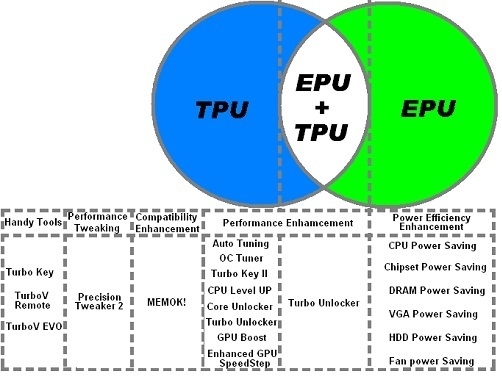Asus Dual Intelligent Processors Review
Dual Intelligent Processors Revealed
Its a tough market alright. As popular as Asus’ products are, they are still up against fearce competition from competitors such as Gigabyte and MSI. These days, factors such as price, aesthetics and reliability tend to be closely matched and so it is only sheer innovation that can maintain a particular brand’s competitive edge. Today, we would like to show you something that could please a rather wide audience; the Asus Dual Intelligent Processors.
I know that some of you are thinking about a single word right now; gimmick. Well not quite as there is no cheating involved here and it is exactly what it claims to be. Asus have combined their previous EPU and Turbo (TPU) based technologies and rolled it into a single feature set labelled DIP.
Everyone likes diagrams and pictures and thankfully Asus have provided us with a lovely Venn diagram to illustrate the meaning of DIP.
Some of you may be wondering why these features are known as processors – its because they are. The power saving EPU revolves around a clever device that interacts directly with your processor to manipulate its frequencies, multipliers and voltages on the basis of system load. The same applies to the TPU, which features a direct link with the System Management BUS and the processor to allow for further enhanced system tweaking and power efficiency. As stated, these devices do not require processor intervention and although they work best with the included software, it is not necessarily required! While competitors might offer similar features, Asus’ offering stands out from the rest by its AI and “hard wired” nature.
For those who can’t help but wonder if you have heard of DIP previously, you probably have. It has indeed been mentioned before but today we have one of many boards to formally support the technology in our labs – the Asus P7H55M/USB3.
So what does DIP mean for end users? Read on.




